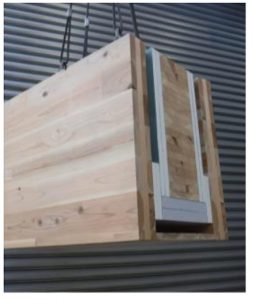Sumitomo Forestry announced that its in-house developed wooden beam has received certification as a two-hour fireproof structural member in February 2020 in Japan, while the pillar passed the performance evaluation test for a two-hour fireproof structural member in March. Source: Timberbiz
These original wooden beam and pillar components are fireproof structural members suitable for use in medium to large scale wooden structures. They are new types that can be manufactured while keeping down prices by using commonly available CLT for the fire-resistant covering.
Existing fireproof wooden components were faced with the issue of high unit cost due to factors such as the use of custom-order fire-resistant covering materials and time-consuming construction processes.
The new wooden beam and pillar components use commonly available non-combustible materials and CLT for their fire-resistant coverings, allowing them to be manufactured while keeping down costs.
Traditionally, the use of CLT centres on structural members with flat surfaces such as walls and floors. Sumitomo Forestry has developed fireproof wooden structural members that use CLT in the fire-resistant coverings of beams and pillars.
The wooden beams and pillars forming the structural support parts of these fireproof structural members are surrounded by non-combustible materials.
CLT is placed on the outside of the non-combustible materials with a gap between the two. By raising the CLT slightly above the non-combustible materials to form a ventilation layer, the gap makes it possible to maintain a smooth surface finishing without being affected by the undulations of the materials below.
With the ventilation layer under the CLT, the design makes it easy for moisture to dry and maintain durability, including helping to drain away water such as when drenched by rain during construction.
The components can be produced in plants and at construction sites. Should there be a fire, the CLT layers can be replaced at construction sites, making repairs easy. Lumber, glulam, LVL and other such wood materials can also be used in place of the exterior CLT, allowing to install house lighting, pipes for sprinklers, and other items.
The fire resistance required of structural members—such as beams and pillars—is regulated by the Building Standards Act (Japan) based on the building’s height and scale. Beam and pillar components of buildings with five or more stories need to be two-hour fireproof structural members, while those used in buildings with 15 or more stories require three-hour fireproofing.
Sumitomo Forestry is working on a concept W350 Plan to realize an environmentally friendly and timber-utilizing city centered on a 350-meter-tall wooden high-rise building in 2041, which will mark the 350th year since the foundation of its business.
With the new research building at Tsukuba Research Institute, completed in October 2019 to form the foundation for the W350 Plan as a base, Sumitomo Forestry will accelerate research and development to increase the value of wood.








